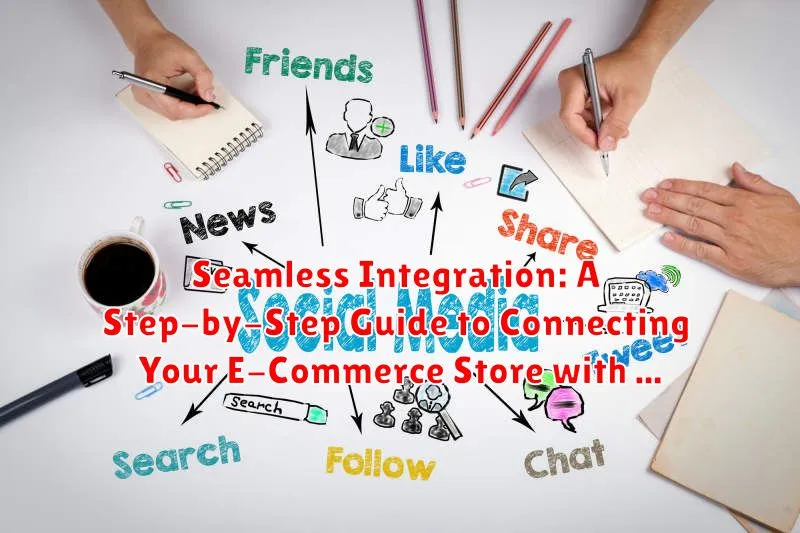In today’s interconnected digital landscape, seamless integration between your e-commerce store and social media platforms is no longer a luxury, but a necessity. This step-by-step guide will provide you with the knowledge and tools necessary to effectively connect your online shop with the power of social media, ultimately driving increased traffic, boosting brand awareness, and maximizing your sales potential. Whether you’re a seasoned online retailer or just starting your e-commerce journey, understanding the nuances of social media integration is crucial for success in the competitive online marketplace. Learn how to leverage platforms like Facebook, Instagram, and more to create a unified brand experience that resonates with your target audience and streamlines the customer journey from discovery to purchase.
This comprehensive guide will walk you through the process of connecting your e-commerce store with social media, covering everything from choosing the right platforms for your business to implementing advanced strategies for social commerce. We’ll explore the benefits of seamless integration, including simplified inventory management, streamlined customer service, and enhanced marketing opportunities. By the end of this guide, you’ll be equipped to build a powerful, integrated online presence that drives significant business growth. Discover how to harness the full potential of social media marketing to reach new customers, engage existing ones, and ultimately transform your e-commerce store into a thriving online hub.
Choosing the Right Social Media Platforms for Your Business
Selecting the right social media platforms is crucial for maximizing your e-commerce store’s reach. Not all platforms are created equal, and your target audience’s preferences should dictate where you invest your time and resources.
Consider these factors when choosing platforms:
- Demographics: Where does your target audience spend their time online?
- Platform Features: Does the platform offer features conducive to e-commerce, such as shoppable posts or integrated advertising options?
- Content Format: Does your brand’s content style align with the platform’s typical content format (e.g., visual platforms like Instagram versus text-based platforms like Twitter)?
- Resources: Do you have the resources to manage multiple platforms effectively?
Researching your competitors’ social media presence can also provide valuable insights. Observe which platforms they prioritize and how they engage with their audience. Focus on choosing a few platforms that align with your business goals and audience demographics rather than spreading your efforts too thin.
Creating a Consistent Brand Presence Across Channels
Maintaining a consistent brand presence across your social media channels is crucial for building brand recognition and trust. This involves presenting a unified brand identity, messaging, and visual style across all platforms.
Key elements of a consistent brand presence include:
- Visual Identity: Use the same logo, color palette, and fonts across all channels.
- Brand Voice: Maintain a consistent tone and style in your communication, reflecting your brand’s personality.
- Messaging: Ensure your core brand message and values are conveyed consistently across different platforms.
- Content Strategy: Tailor your content to each platform while maintaining a consistent overall theme and message.
By creating a cohesive and recognizable brand experience, you can strengthen your brand image and foster customer loyalty. This consistency helps customers easily identify and connect with your brand, regardless of the platform they are using.
Integrating Your E-Commerce Platform with Social Media
Direct integration between your e-commerce platform and social media channels streamlines various processes. This integration allows for synchronized product catalogs, enabling real-time updates of inventory and pricing across platforms. Changes made on your e-commerce store automatically reflect on your social media shop, reducing manual updates and ensuring consistency.
Several methods facilitate this integration. Many e-commerce platforms offer built-in plugins or extensions for popular social media channels. These tools often provide a simplified setup process, guiding you through the necessary steps to connect your accounts. For more complex integrations, utilizing APIs (Application Programming Interfaces) offers greater flexibility and customization.
Choosing the right integration method depends on your platform and technical capabilities. Plugins are generally user-friendly, while API integrations may require developer assistance. Regardless of the chosen method, a successful integration ensures a seamless experience for your customers, making purchasing easier and more efficient.
Leveraging Social Media for Customer Service and Engagement

Social media has transformed customer service, offering immediate and personalized support. Transform your social media presence into a powerful customer service hub.
Respond promptly to inquiries. Quick responses show customers you value their time and concerns. Aim to answer questions within a reasonable timeframe, publicly acknowledging the request and offering to assist.
Use direct messaging for personalized support. Private conversations allow for detailed troubleshooting and sensitive information sharing, enhancing the customer experience.
Monitor brand mentions and engage proactively. Track conversations about your brand and address both positive and negative feedback. Thank customers for positive reviews and offer solutions to those expressing dissatisfaction.
Create a dedicated customer service account (optional). A separate account can streamline customer service inquiries and build a dedicated community.
Use social listening tools. These tools can help you identify trends, understand customer sentiment, and improve your products and services based on feedback.
Running Targeted Advertising Campaigns on Social Media
Targeted advertising empowers e-commerce businesses to reach specific customer segments with tailored promotions. By leveraging social media platforms’ advertising capabilities, you can optimize your ad spend and maximize your return on investment (ROI).
Begin by clearly defining your target audience. Consider demographics, interests, behaviors, and even purchase history. This information helps create highly relevant ads that resonate with potential customers.
Most social media platforms offer detailed ad targeting options. Experiment with different targeting parameters to identify the most effective combinations for your business. Continuously monitor and analyze campaign performance metrics such as click-through rates, conversion rates, and cost-per-click.
A/B testing is essential for optimizing your ad campaigns. Test different ad creatives, headlines, and calls to action to determine what resonates best with your target audience. Refine your campaigns based on data-driven insights.
Finally, set a realistic budget and allocate your resources strategically across different platforms and campaigns. Regularly review your budget and adjust accordingly based on performance data.
Tracking and Measuring Your Social Commerce Success
Effectively tracking your social commerce initiatives is crucial for understanding what works and what doesn’t. This data-driven approach allows you to optimize your strategies for maximum impact. Begin by establishing clear, measurable key performance indicators (KPIs).
Some essential KPIs to consider include conversion rate, click-through rate (CTR), average order value (AOV), and customer lifetime value (CLV) from social media channels. Monitor these metrics closely to identify trends and patterns.
Utilize analytics platforms provided by each social media platform. These tools offer valuable insights into audience demographics, engagement, and post performance. Furthermore, leverage your e-commerce platform’s analytics to track sales originating from social media.
By consistently analyzing these metrics, you can refine your social commerce strategy, allocate resources efficiently, and ultimately, drive more sales.
Best Practices for Social Media Content Creation

Creating engaging social media content is crucial for driving traffic to your e-commerce store. High-quality visuals are essential. Use professional, well-lit product photos and videos. Consider lifestyle shots to showcase your products in context.
Compelling copy is just as important. Write concise, informative captions that highlight key features and benefits. Use a consistent brand voice across all platforms. Engage with your audience by asking questions and responding to comments.
Tailor your content to each platform. Instagram is ideal for visually driven content, while Twitter is better suited for short, timely updates. Consider the specific audience for each platform and adjust your strategy accordingly. Hashtags are a valuable tool for increasing discoverability. Research relevant hashtags and use them strategically.
Consistency is key. Develop a regular posting schedule to keep your audience engaged. Use social media management tools to schedule posts in advance. Finally, analyze your results and adapt your strategy based on what resonates with your audience.

